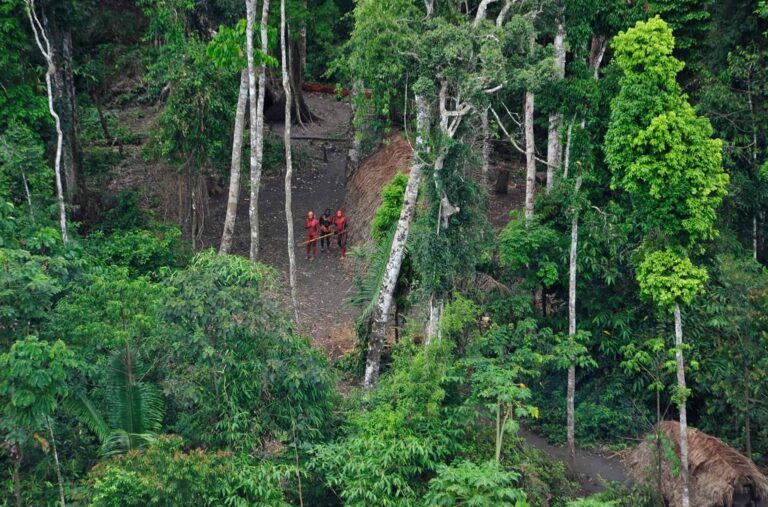It is hard to believe, in this day and age of instantaneous global communication, that there are still tribes that are largely isolated from the rest of the world.
There are still an estimated one hundred to two hundred groups of Indigenous peoples across Pacific Island and South America. Who have not had significant contact with the outside world.
But how can we define an “uncontacted” tribe? A tribe that has never had any contact with the outside world is not necessarily considered “primitive.”
And there is a lot of evidence to propose that almost all uncontacted tribes are cognisant of the outside world and deliberately avoid contact with it, often to protect themselves from exploitation and violence. Instead, it describes tribes that rarely interact with one another through means like trade or travel.
Table of Contents
The still uncontacted tribes in the world
Although the number of uncontacted tribes is decreasing, little is known about those that remain. Here’s a list of the uncontacted tribes in the world.
1. The Sentinelese from Andaman Islands, India
This group of people is so far removed from the rest of humanity that they subsist solely on hunting and gathering. The exact population of this island-dwelling Indian subcontinent group is unknown, but estimates place it between 200 and 250 people.
The Raj made contact with them in the 19th century. But they have never been friendly toward strangers, instead firing arrows at anyone who comes too close.
Their 1996 attempted contact has been followed by silence. Little is known about the Sentinelese, except that they make their own metal tools out of scrap iron they find in shipwrecks.
2. The Awa of Brazil
The Awá are “the world’s most threatened tribe,” according to Survival International. In the eastern Amazon rainforest, the Awá people have had a lot of trouble with logging companies that want to cut down trees on their land.
About 100 members of the tribe have never had any kind of exposure to the outside world. The total population of the tribe is only about 350.
World Bank and EU loans to Brazil’s government in 1982 included travelers demanding that the areas of Indigenous peoples, including the Awá, be protected, but Brazil has not always lived up to its end of the bargain.
An Awá girl of 8 years old was burned to death by illegal loggers in 2011. In addition to the reported murders, authorities believe there have been many more killings of indigenous people in the area.
3. The Nomole of Peru
The Mashco Piro are one of the fifteen or so uncontacted peoples who call the Amazonian forest of Peru home. As far as the government is concerned, there are fewer than 800 Mashco Piro.
They have a reputation for making arrows from bamboo and hunting turtles for their eggs. They used to avoid contact with the outside world, but in recent years they have made more of an effort to do so. The deforestation and oil industries are serious external threats.
4. The indigenous tribe of Ayoreo
The Ayoreo who remain uncontacted are a small but significant subset of the Ayoreo overall. The majority of the Ayoreo were converted (sometimes forcibly) from their traditional hunter-gatherer culture to a more settled one by European missionaries.
Out of a total population of about 5,600 Ayoreo in Paraguay and Bolivia, only about 100 have yet to be located and contacted. Approximately six distinct groups of uncontacted people call the Gran Chaco region home.
Their voluntary isolation from the outside world is challenged by livestock farming and deforestation. Also, by the sale of Ayoreo lands to oil speculators and other outsiders despite legal protections.
5. Kawahiva population, Brazil
Deforestation of the Amazon rainforest in Brazil may have pushed the Kawahiva people into adopting a nomadic lifestyle. Approximately 30 of the red head people, as they are known to the surrounding tribes, are thought to still be alive today.
It is not exactly a surprise that the Kawahiva do not get along with outsiders considering how small their territory has become. This nomadic tribe gets by on a diet of game and berries. And it is known that they also climb ladders to get to the honeybees in the trees.
6. Uncontacted population of West Papua
Survival International estimates that there are more than 40 isolated tribe groups residing in the West Papua region of New Guinea’s rainforests. Which is under the jurisdiction of the Indonesian government.
The region where the uncontacted peoples live is nearly nonexistent. And reporters and human rights activists are banned from the area by the government.
Disease, commercial exploitation, military repression, and “deep-seated racism”, described as “endemic” in Indonesian New Guinea, are all mentioned as potential dangers to these uncontacted groups. The Indonesian occupation began in 1963, and Survival International figures that since then, around 100,000 indigenous people have been killed.
These indigenous tribes have preserved their culture for thousands of years
The aforementioned uncontacted tribes have no way of communicating with the outside world. Many of these groups have preserved their traditional ways even as other peoples have changed over time.
Their unique culture, including their cults and religions, rituals, way of dressing and survival mode, has been preserved for hundreds, if not thousands, of years. They reside in remote areas, such as the mountains of New Guinea, the islands off the coast of India, the depths of the Amazon.
Their survival is today largely at risk. This is both for external diseases, to deforestation, lifestock practices and nature exploitation, to the governments negligence in protecting these populations, that in this global age, want to remain hidden.
Read also: These are the world friendliest countries according to the rankings












